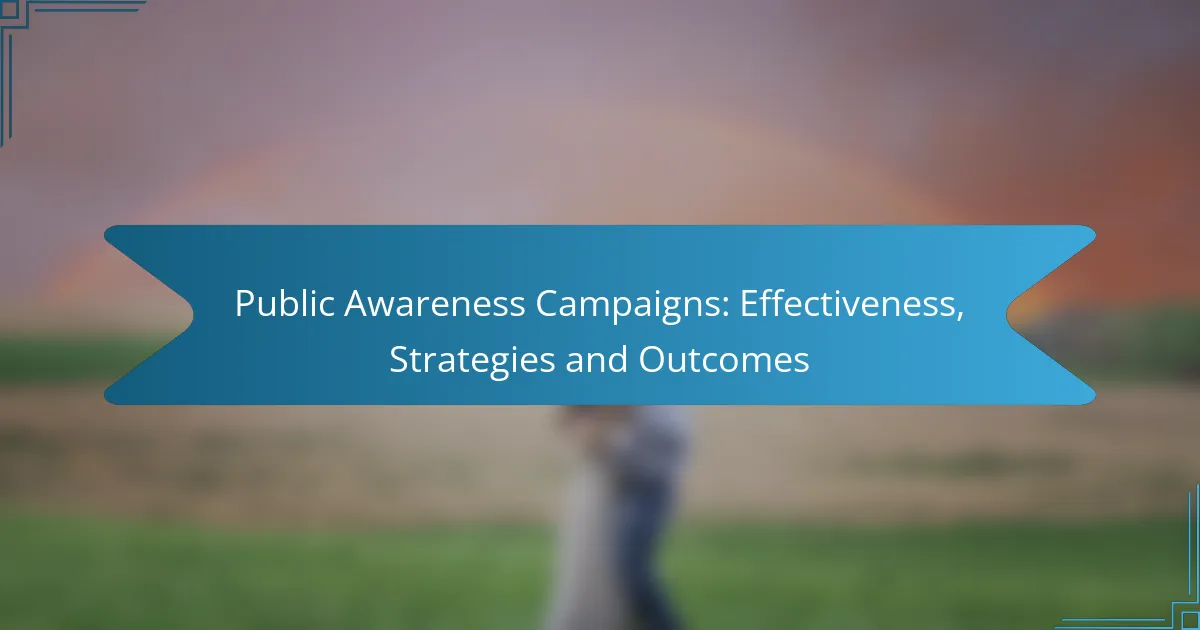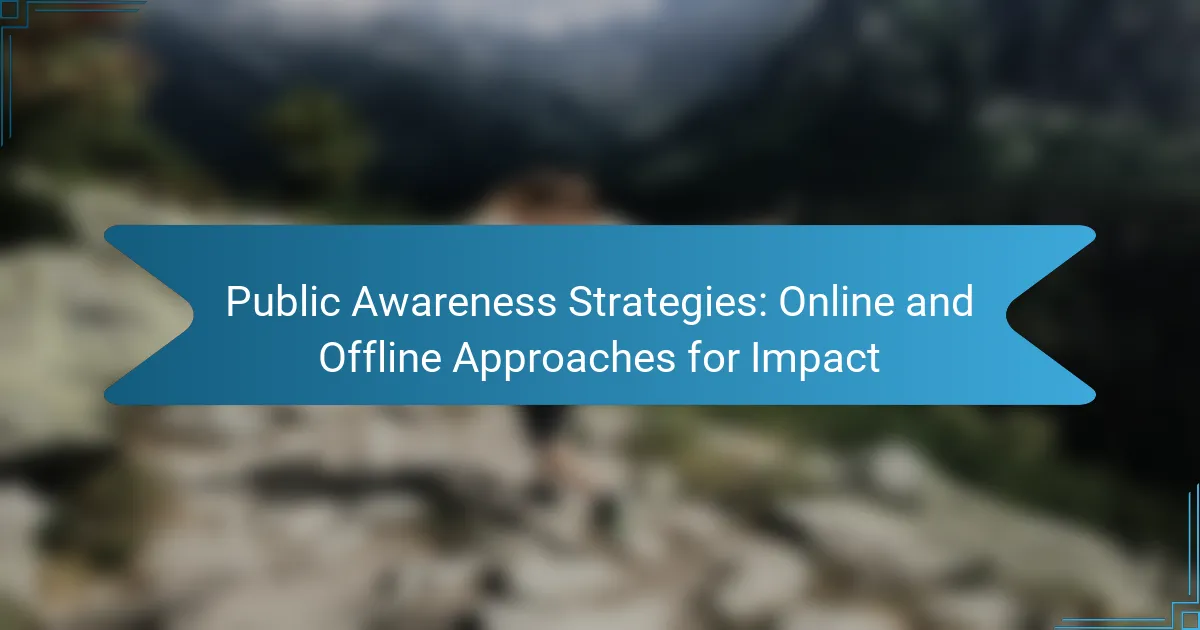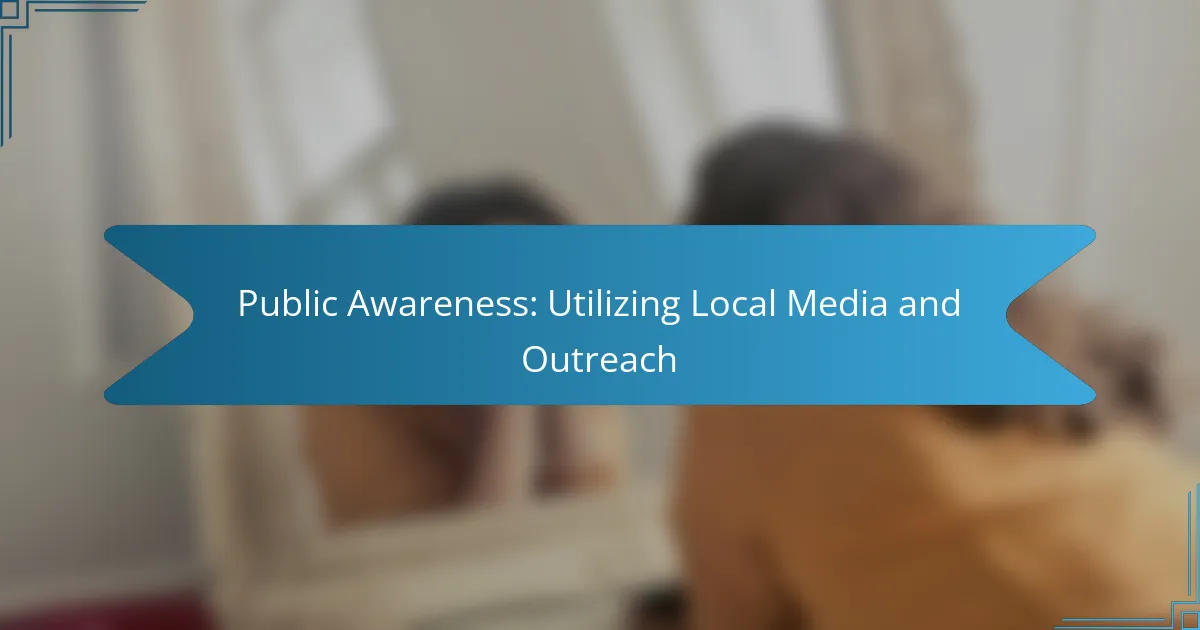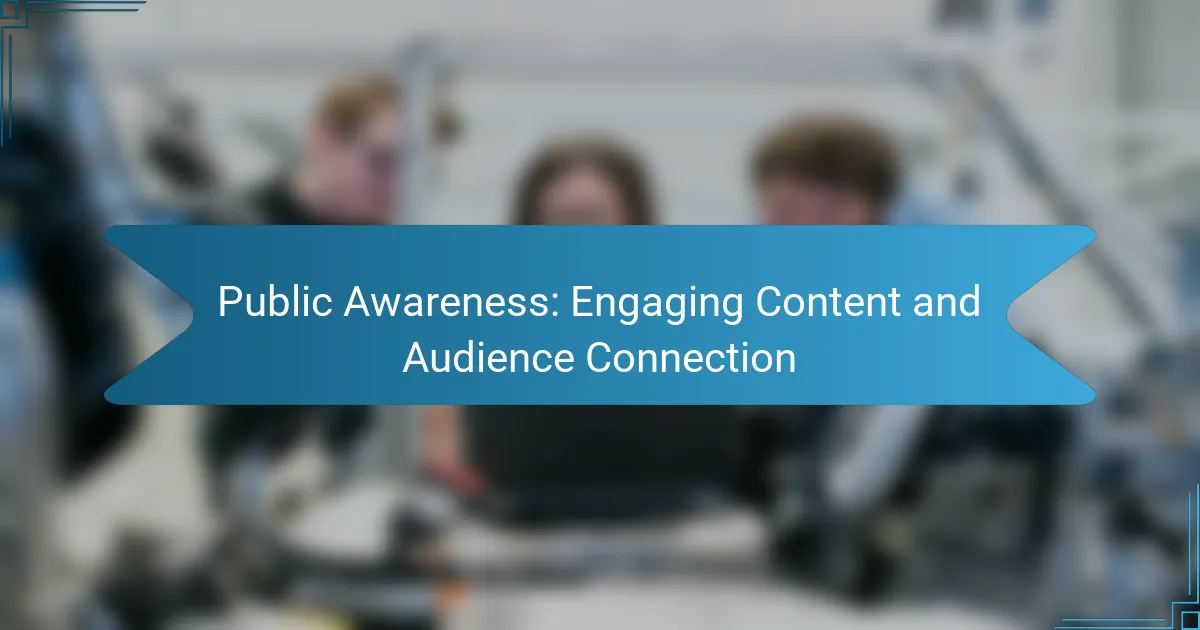Public awareness campaigns play a crucial role in informing and engaging communities on important issues. By employing effective strategies that focus on audience engagement and data utilization, these campaigns aim to foster behavioral change and enhance message retention. However, challenges such as budget constraints and audience engagement can impact their overall effectiveness.

What Are the Most Effective Public Awareness Campaign Strategies?
Effective public awareness campaign strategies focus on engaging the target audience, leveraging data, and fostering community participation. These approaches enhance message retention and encourage behavioral change.
Social Media Engagement
Social media engagement is crucial for reaching a broad audience quickly. Campaigns can utilize platforms like Facebook, Instagram, and Twitter to share compelling content that resonates with users, encouraging shares and interactions.
To maximize impact, create shareable graphics, videos, or infographics that simplify complex information. Regularly interact with followers through comments and messages to build a community around the campaign.
Community Involvement
Community involvement fosters a sense of ownership and relevance in public awareness campaigns. Engaging local organizations, schools, and businesses can amplify the message and encourage grassroots participation.
Consider hosting local events, workshops, or informational sessions to directly connect with the community. This approach not only raises awareness but also builds trust and credibility for the campaign.
Data-Driven Targeting
Data-driven targeting ensures that campaigns reach the right audience effectively. By analyzing demographics, behaviors, and preferences, organizations can tailor their messages to specific groups for maximum impact.
Utilize tools like Google Analytics and social media insights to gather data on audience engagement. Adjust your strategies based on this information to improve outreach and effectiveness continuously.
Collaborations with Influencers
Collaborating with influencers can significantly boost the visibility of public awareness campaigns. Influencers often have dedicated followings that trust their opinions, making them effective advocates for your cause.
Select influencers whose values align with your campaign and who resonate with your target audience. This partnership can take the form of sponsored posts, live events, or co-created content that highlights the campaign’s goals.
Use of Visual Storytelling
Visual storytelling is an impactful way to convey messages in public awareness campaigns. Utilizing images, videos, and graphics can help simplify complex topics and evoke emotional responses from the audience.
Consider creating short videos or animated clips that illustrate the campaign’s message. Infographics can also effectively present statistics and information in an easily digestible format, making the content more shareable.

How Do Public Awareness Campaigns Measure Success?
Public awareness campaigns measure success through various metrics that reflect their impact and effectiveness. Key methods include analyzing performance indicators, gathering feedback from target audiences, and evaluating engagement on social media platforms.
Key Performance Indicators (KPIs)
Key Performance Indicators (KPIs) are essential metrics that help assess the effectiveness of public awareness campaigns. Common KPIs include reach, impressions, engagement rates, and conversion rates, which indicate how well the campaign is resonating with its audience.
For example, a campaign aimed at increasing vaccination rates might measure the number of people who booked appointments after seeing the campaign materials. Setting specific, measurable goals for each KPI is crucial for evaluating success.
Surveys and Feedback
Surveys and feedback provide direct insights into how the target audience perceives the campaign. Conducting pre- and post-campaign surveys can help gauge changes in awareness, attitudes, and behaviors related to the campaign’s objectives.
For instance, a campaign promoting environmental conservation might include questions about participants’ recycling habits before and after the campaign. This method allows organizations to adjust strategies based on audience responses and improve future initiatives.
Social Media Metrics
Social media metrics are vital for understanding audience engagement and reach in real-time. Metrics such as likes, shares, comments, and follower growth can indicate how well the campaign is performing on platforms like Facebook, Twitter, and Instagram.
For example, a campaign that encourages healthy eating might track the number of shares of its recipe posts or the increase in followers on its health-focused social media accounts. Monitoring these metrics helps organizations refine their messaging and target their audience more effectively.

What Are Common Challenges in Public Awareness Campaigns?
Public awareness campaigns often face several challenges that can hinder their effectiveness. Key issues include budget constraints, audience engagement problems, and the clarity of the message being communicated.
Budget Constraints
Budget constraints are a significant hurdle for many public awareness campaigns. Limited funding can restrict the reach and frequency of the campaign, impacting its overall visibility and effectiveness.
To navigate budget limitations, prioritize spending on high-impact channels. For instance, digital advertising can often provide a more cost-effective solution compared to traditional media. Consider leveraging partnerships or sponsorships to extend your budget.
Audience Engagement Issues
Engaging the target audience is crucial for the success of any public awareness campaign. If the audience does not feel connected or interested, the campaign’s message may not resonate.
To enhance engagement, tailor content to the audience’s preferences and behaviors. Use interactive elements such as polls or social media challenges to foster participation. Regularly gather feedback to adjust strategies and improve connection.
Message Clarity
Clarity of message is essential in ensuring that the audience understands the campaign’s goals. Ambiguous or overly complex messages can lead to confusion and disengagement.
To ensure clarity, use simple language and direct calls to action. Test messages with a small segment of the target audience before full rollout to identify any potential misunderstandings. Aim for consistency across all platforms to reinforce the core message.

How Do Cultural Factors Influence Campaign Effectiveness in the UK?
Cultural factors significantly impact the effectiveness of public awareness campaigns in the UK by shaping how messages are perceived and accepted. Understanding these influences can help tailor campaigns to resonate better with diverse audiences across different regions.
Regional Sensitivities
In the UK, regional sensitivities vary widely, affecting how campaigns are received. For example, campaigns addressing health issues may need to consider local attitudes towards healthcare, which can differ between urban and rural areas. Tailoring messages to reflect local values can enhance engagement and effectiveness.
Moreover, understanding historical contexts and current events in specific regions can guide the tone and content of the campaign. For instance, a campaign in Scotland may need to address different political sentiments compared to one in England, ensuring that the messaging is relevant and respectful.
Language and Dialect Considerations
Language and dialect play a crucial role in shaping the effectiveness of campaigns in the UK. Utilizing local dialects or colloquial language can create a sense of familiarity and trust, making the message more relatable. For instance, a campaign in Wales might incorporate Welsh phrases to connect better with the audience.
Additionally, campaigns must consider the linguistic diversity present in the UK, including various immigrant communities. Providing materials in multiple languages can significantly increase outreach and ensure that non-native speakers fully understand the campaign’s message.
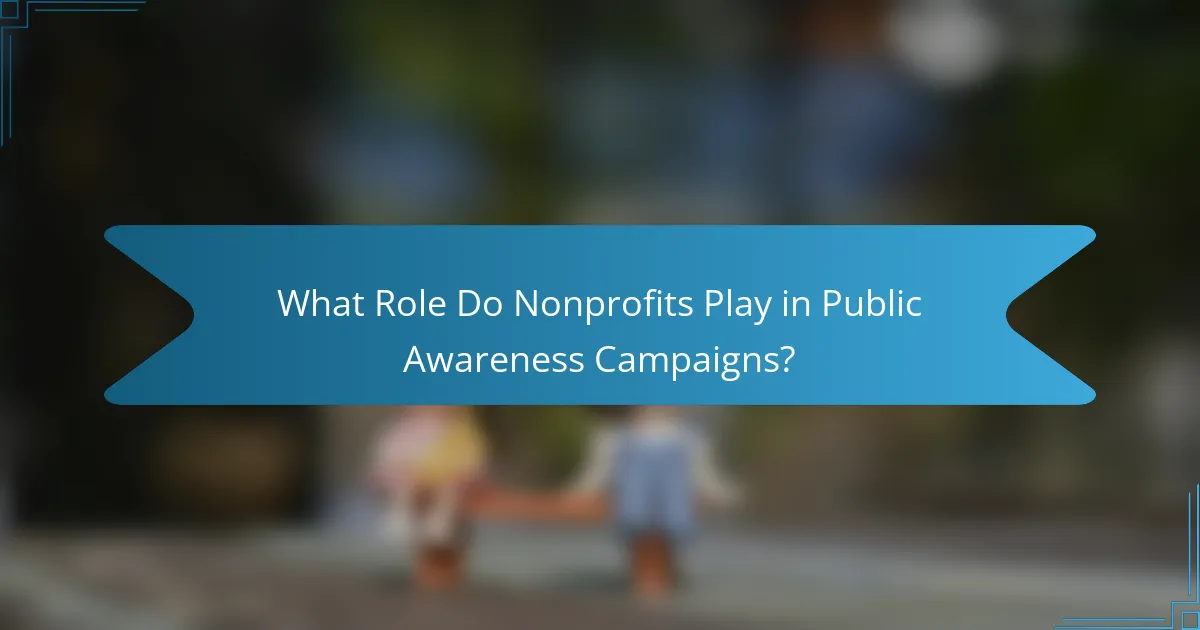
What Role Do Nonprofits Play in Public Awareness Campaigns?
Nonprofits play a crucial role in public awareness campaigns by leveraging their mission-driven focus to educate and engage communities. They often serve as trusted voices on social issues, mobilizing resources and volunteers to amplify their messages effectively.
Partnerships for Greater Reach
Nonprofits often collaborate with businesses, government agencies, and other organizations to expand their outreach. These partnerships can enhance visibility and credibility, allowing campaigns to reach diverse audiences. For example, a health nonprofit might partner with a local hospital to promote wellness initiatives, benefiting from the hospital’s established community presence.
When forming partnerships, nonprofits should seek organizations that share similar values and goals. This alignment ensures that messaging is consistent and resonates with the target audience. Additionally, leveraging each partner’s strengths can lead to more impactful campaigns.
Resource Sharing
Resource sharing is essential for nonprofits to maximize their impact in public awareness campaigns. By pooling resources such as funding, expertise, and volunteer networks, nonprofits can execute more comprehensive initiatives. For instance, two nonprofits might share marketing materials and event spaces to host joint awareness events, thereby reducing costs and increasing attendance.
Nonprofits should actively seek opportunities to share resources with other organizations. This could involve co-hosting workshops, sharing social media platforms, or collaborating on research initiatives. However, it’s important to establish clear agreements to ensure that all parties benefit and that the campaign’s integrity is maintained.
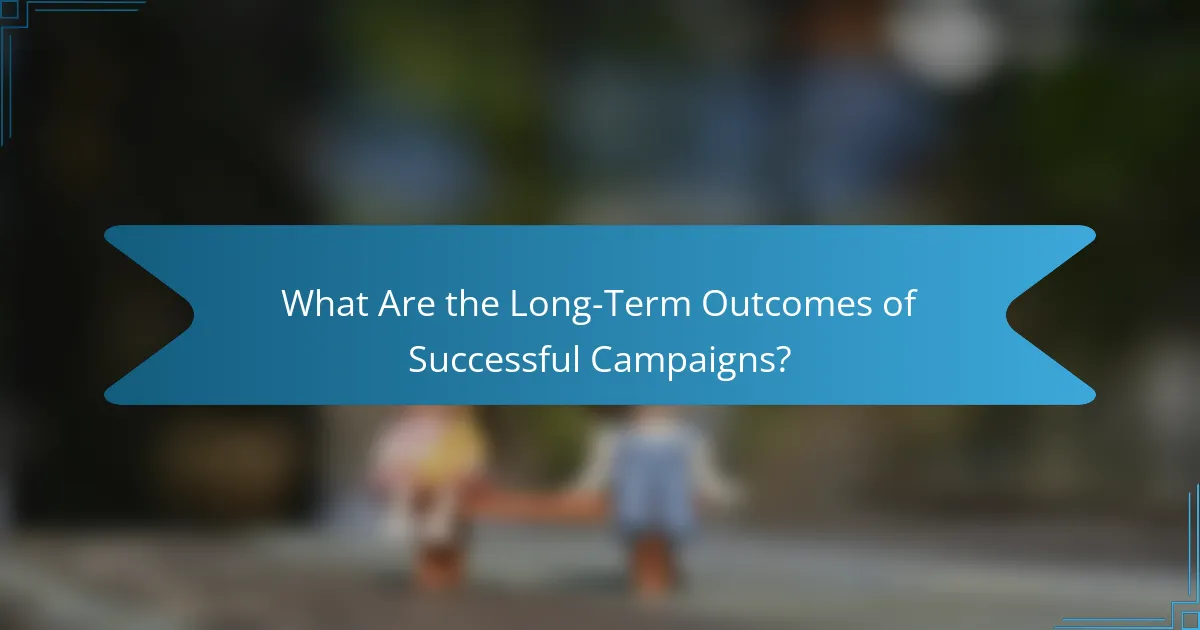
What Are the Long-Term Outcomes of Successful Campaigns?
Successful public awareness campaigns can lead to significant long-term outcomes, such as sustained behavioral change, increased knowledge, and improved community engagement. These outcomes often manifest over time, reflecting the campaign’s effectiveness in altering public perceptions and actions.
Behavioral Change
Behavioral change is a primary outcome of effective public awareness campaigns, aiming to shift individuals’ actions in a desired direction. For instance, campaigns promoting healthy eating may lead to increased consumption of fruits and vegetables among targeted populations.
To achieve lasting behavioral change, campaigns should employ strategies such as clear messaging, relatable storytelling, and community involvement. Engaging local influencers can enhance credibility and encourage participation, making the desired behavior more appealing.
Common pitfalls include failing to provide ongoing support or resources after the campaign ends. To avoid this, consider implementing follow-up initiatives or partnerships with local organizations to maintain momentum and reinforce positive behaviors over time.
